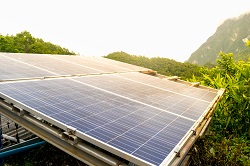More efficient use of solar energy
Minimising dependence on fossil fuels by exploiting clean and renewable forms of energy has become a key EU priority for reducing greenhouse gas (GHG) emissions while ensuring a stable and reliable supply of energy at a reasonable cost. Solar energy is one of the main players in the renewable energy field and photovoltaic (PV) power systems are becoming increasingly common. In particular, grid-connected PV systems that are connected to the mains utility grid supply it with excess power when a surplus exists and draw electricity when demand exceeds supply. European researchers sought to enhance current PV technology with funding for ‘The developement of a new more efficient grid connected PV module’ (Optisun). Specifically, they set out to develop technology for producing subdivided solar cells, a solar cell-integrated micro-inverter, and a backlight reflector to maximise efficiency of energy capture and usage. Solar cells subdivided into eight parts with equal current output were achieved by laser dicing with inkjet printing of conductive paste for interconnection.To achieve compatibility with the mains grid, researchers bonded a micro-inverter to the subdivided solar cells to convert the DC current to AC and ‘step up’ the small voltage of the solar cells (3 V) to the high voltage of the electricity grid (220 V). The backlight module was designed to utilise empty space between solar cells by transferring light to the rear side of the solar panel, generating additional solar power. Extensive research was required to select optimal materials for transmission of wavelengths of light most critical for power production and for coating material to reflect light from the transmissive material onto the PV cell. Researchers created a fully functioning prototype PV module that demonstrated increased efficiency of the solar cell with the back light module. Optisun technologies have the potential to increase the competitiveness of the European PV industry currently lagging behind American and Asian counterparts. With increased energy efficiency and cost-effectiveness, commercialisation could provide important benefits to consumers as well.







